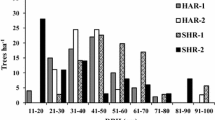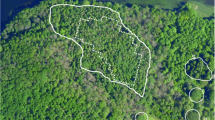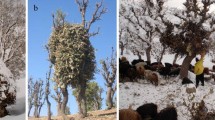Abstract
Forest grazing has been recognised as being a useful tool in fire-risk reduction, in addition to having the potential to preserve or enhance forest biodiversity if managed correctly. Concern for natural regeneration of forest trees in Europe has also prompted interest in the effects of large herbivores on seedling and sapling growth and mortality. An investigation was carried out into sapling damage and density of natural regeneration of oak (Quercus robur) in a mature, pony-grazed, Pinus radiata forest in Galicia, NW Spain under two different grazing regimes (continuous and rotational). In all treatments significantly more oak seedlings and saplings were recorded in areas of grass sward than areas dominated by taller ground flora species. Damage to oak saplings was assessed from the form (height and canopy) relative to stem diameter. The height and average canopy diameter of similar-aged saplings were found to be significantly greater in ungrazed (control) than both continuous and rotationally grazed treatments. Height and canopy diameters of similar-aged oak were not significantly different between the two grazing treatments. Significant differences were observed in tree form, with unbrowsed saplings having the greatest height to canopy width ratio and those in the continuously browsed plots having the smallest. An obvious decrease in the goodness of fit (R2) of regression analyses were found in continuously grazed areas compared to rotational and control plots for both height and canopy data. The differences in damage observed were not significantly different enough to suggest one method of grazing over the other as being better for minimising sapling damage. Management requirements are more likely to dictate grazing regime. Overall, stock density is likely to have a more significant effect on damage than stocking system.
Similar content being viewed by others
References
Anon (1996) Grazing in upland woods: managing the impacts. Managing the English upland booklet series English Nature Peterborough
J. Butterschon R.M. Butterschon (1978) ArticleTitleThe effect of browsing by cattle and sheep on trees and bushes Natura Jutlandica 20 79–94
W. Cramer (2001) ArticleTitleFire ecology, Mediterranean forests and global change Forest Ecol. Manag. 147 1–2
N.R. Draper H. Smith (2001) Applied Regression Analysis Wiley New York 672
B.M.S. Dunlop (1975) ArticleTitleRegeneration of our native pine woods Scot. Far. 29 111–119
M. Étienne (1996) Western European silvopastoral systems INRA Paris
A.H. Fitter R.D. Jennings (1975) ArticleTitleThe effects of sheep grazing on the growth and survival of seedling junipers (Juniperus communis L.) J. Appl. Ecology 12 637–642
GillR .M.A.1992 A review of damage by mammals in north temperate forests 1. Deer. Forestry 65.
R.M.A. Gill V. Beardall (2001) ArticleTitleThe impact of deer on woodlands: the effects of browsing and seed dispersal on vegetation structure and composition Forestry 74 209–218 Occurrence Handle10.1093/forestry/74.3.209
M.P. González-Hernández F.J. Silva-Pando (1996) ArticleTitleGrazing effects of ungulates in a Galician oak forest Forest Ecol. Manag. 88 65–70
A.J. Hester L. Edenius R.M. Butterschon A.T. Kuiters (2000) ArticleTitleInteractions between forests and herbivores: the role of controlled grazing experiments Forestry 73 381–391 Occurrence Handle10.1093/forestry/73.4.381
A.J. Hester K.J. Kirby F.J.G. Mitchell R.M.A. Gill J. Latham H. Armstrong (1998) Ungulates and forest management in Great Britain and Ireland J. Humphrey R. Gill J. Claridge (Eds) Grazing as a Management Tool in European Forest Ecosystems Forestry Commission Edinburgh 24–35
A.J. Hester F.J.G. Mitchell K. Kirby (1996) ArticleTitleEffects of season and intensity of sheep grazing on tree regeneration in a British upland woodland Forest Ecol. Manag. 88 99–106
J.W. Humphrey M.D. Swaine (1997) ArticleTitleFactors affecting the natural regeneration of Quercus in Scottish oakwoods I. Competition from Pteridium aquilinum J. Appl. Ecol. 34 577–584
Y. Ide T. Miyashige S. Sato K. Shijimaya (2001) ArticleTitleGrazing in secondary forest developed on abandoned field in southwestern Japan 1. Characteristics of cattle tracks formed in secondary forest Grassland Sci. 47 134–138
H. Kampf (2000) ArticleTitleThe role of large grazing animals in nature conservation - a Dutch perspective Brit. Wildlife 37 37–46
K.J. Kirby F.J. Mitchell A.J. Hester (1994) ArticleTitleA role for large herbivores (deer and domestic stock) in nature conservation management in British semi-natural woods Arboricult. J. 18 381–399
A.T. Kuiters K.J. Kirby (1999) ArticleTitleMethodologies in forest grazing research Forest Ecol. Manag. 120 1–2
A.T. Kuiters G.M.J. Mohren S.E. Wieren ParticleVan (1996) ArticleTitleUngulates in temperate forest ecosystems Forest Ecol. Manag. 88 1–5
L. Kuiters (1998) Ungulates and forest management in the Netherlands J. Humphrey R. Gill J. Claridge (Eds) Grazing as a management tool in European Forest Ecosystems Forestry Commission Edinburgh 11–19
McEvoy P.M., Flexen M., Cameron A. and McAdam J.H. 2003. A comparison of botanical diversity in grazed and ungrazed woodlands in Northern Ireland; suggestions for grazing management. unpublished.
B. Mayle (1999) Domestic stock grazing to enhance woodland biodiversity, Rep. No. Information Note 28 Forestry Commission Edinburgh
K. Miles J.W. Kinnaird (1979) ArticleTitleThe establishment and regeneration of birchjuniper and Scots pine in the Scottish Highlands Scott. Forest. 33 102–107
F.J.G. Mitchell K.J. Kirby (1990) ArticleTitleThe impact of large herbivores on the conservation of semi-natural woods in the British uplands Forestry 63 333–353
G.F. Peterken (1996) Woodland Conservation and Management EditionNumber2 Chapman and Hall London
R. Putman (1994) ArticleTitleEffects of grazing and browsing by mammals on woodlands Brit. Wildlife 5 205–213
R.J. Putman (1996) ArticleTitleUngulates in temperate forest ecosystems: perspectives and recommendations for future research Forest Ecol. Manag. 88 205–214
A. Rigueiro-Rodríguez F.J. Silva-Pando R. Rodríguez-Soalleiro P.A. Castillón-Palomeque P. Álvarez-Álvarez R. Mosquera-Losada R. Romero-Franco M.P. González-Fernández (1997) Manual de sistemas silvopastorales ADAPT Santiago de Compostela
F.J. Silva-Pando M.P. González-Hernández (1992) ArticleTitleAgroforestry helps prevent forest fires Agroforest. Today 4 7–8
E.E. Starkey P.J. Happe M.P. Gonzalez-Hernanadez K.M. Lange J.J. Karchesy (1999) Tannins as Nutritional Constraints for Elk and Deer of the Coastal Pacific Northwest Polyphenols 2: Chemistry, Biology, Pharmacology, Ecology (ed Gross) Kluwer Academic/Plenum Publishers New York
J.F. Vallentine (2001) Grazing management EditionNumber2 Academic Press San Diego 659
Van Wieren S.E. 1995. The potential role of large herbivores in nature conservation and extensive land use in Europe. In: Bullock D.J. and Harvey H.J. (eds), The National Trust and Nature Conservation: 100 years on Biological Journal of the Linnaean Society, Vol. 56. pp. 11–23.
F.W.M. Vera (2000) Grazing ecology and forest history CAB International Wallingford
Author information
Authors and Affiliations
Corresponding author
Rights and permissions
About this article
Cite this article
McEvoy, P.M., McAdam, J.H., Mosquera-Losada, M.R. et al. Tree Regeneration and Sapling Damage of Pedunculate Oak Quercus robur in a Grazed Forest in Galicia, NW Spain: A Comparison of Continuous and Rotational Grazing Systems. Agroforest Syst 66, 85–92 (2006). https://doi.org/10.1007/s10457-005-2916-0
Received:
Accepted:
Issue Date:
DOI: https://doi.org/10.1007/s10457-005-2916-0




